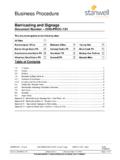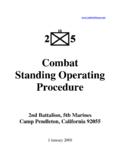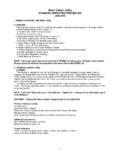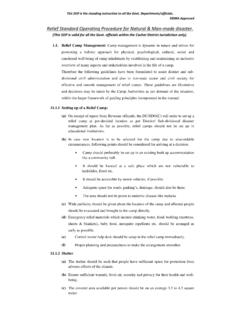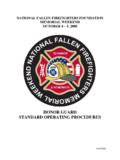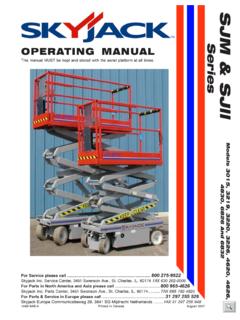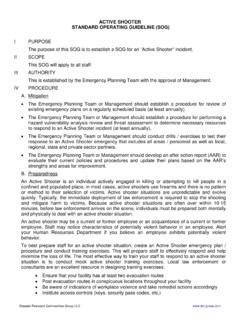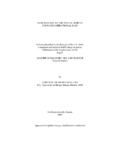Transcription of Business Procedure - Stanwell
1 Business Procedure WRITTEN BY: .. NAME: ENDORSED/CHECKED BY: .. NAME: APPROVED BY: .. NAME: DATE: .. Doc No: OHS-PROC-08 Revision No: 0 Revision Date: Page: 1 of 14 THIS DOCUMENT IS UNCONTROLLED IN HARD COPY FORMAT Lifting Operations Document Number OHS-PROC-08 This document applies to the following sites: All Sites Rockhampton Office Brisbane Office Tarong Site Barron Gorge Hydro PS Kareeya Hydro PS Mica Creek PS Koombooloomba Hydro PS Swanbank PS Mackay Gas Turbine Wivenhoe Small Hydro PS Stanwell PS Meandu Mine Table of Contents Purpose .. 2 Scope .. 2 Actions .. 2 Design .. 2 Safe Systems of Work Requirements .. 2 Lift Planning .. 3 Work Environment Requirements .. 3 Exclusion Zone .. 3 Overhead Electrical 3 Plant and Equipment 3 Register .. 3 Identification and compliance .. 3 Certification .. 4 Inspection and Maintenance.
2 4 Removal from Service .. 4 Equipment for Lifting Personnel .. 4 Safe Work Practice Requirements .. 5 Positioning .. 6 Using other Mobile Plant for Lifting Operations .. 6 Use of Temporary Lifting Points .. 6 Training and Competency Requirements .. 6 References (Including Information Services) .. 7 Definitions .. 8 Revision History .. 8 Appendices .. 9 Appendix A Lifting Operations Document Flowchart .. 9 Appendix C Technical Standards .. 11 Appendix D High Risk Licence Requirements .. 12 Appendix E Training & Competency Decision Flow Chart .. 14 Doc No: OHS-PROC-08 Revision No: 0 Revision Date: Page: 2 of 14 THIS DOCUMENT IS UNCONTROLLED IN HARD COPY FORMAT Purpose This Business Procedure defines Stanwell s minimum mandatory requirements for conducting lifting operations safely in Stanwell workplaces. It covers all lifting and hoisting operations using cranes, hoists and winches.
3 Scope This Business Procedure applies throughout Stanwell , all its sites and all activities under Stanwell s control. It applies to all Stanwell employees and contractors, including visitors to Stanwell workplaces. This Business Procedure does not apply to: operational and maintenance requirements for plant, refer to Business Procedure : Powered Mobile Plant; or manual lifting, refer Business Procedure : Hazardous Manual Tasks. This Business Procedure applies to forklifts where they are used for lifting operations that are outside of using just the forklift tynes and require rigging to be performed ( using a jib attachment etc.). It is expected that all lifting operations using forklifts will be classified as a standard lift (refer to Appendix B Lift Classification). Actions Design Actions shall be taken to optimise the layout, constructability, operability, maintainability and accessibility of facilities to eliminate or minimise the need for lifting operations.
4 As a minimum the following shall occur: identify foreseeable lifts during the design of facilities; identify opportunities for installing fixed lifting devices for routine lifts; ensure access for mobile lifting equipment; and plan lifting activities to minimise risks associated with lifting operations. Safe Systems of Work Requirements Where practicable, the requirement to perform lifting operations shall be eliminated. Where elimination is not possible the need to perform lifting operations shall be minimised as far as practicable. The following shall occur: lifting operations are classified and planned; plant and equipment is certified fit for use; lifting operations are performed only by trained and familiarised personnel; and lifting operations are assessed to identify potential hazards and make sure suitable risk control measures are put in place.
5 Doc No: OHS-PROC-08 Revision No: 0 Revision Date: Page: 3 of 14 THIS DOCUMENT IS UNCONTROLLED IN HARD COPY FORMAT Lift Planning Lifting operations shall be risk assessed and planned in accordance with Appendix B Lift Classification. For repeated or routine operations, such planning is only necessary once, provided that an operating Procedure or standard work method statement (WMS) is in place or documented in another way. Periodic revisions shall be carried out to make sure that no factors have changed. The planning of all lifting operations shall as a minimum ensure that: all personnel involved with lifting operations are trained / familiarised; the travel path is clarified and any obstacles are removed before lifting commences; barricading, signage and or spotter/s are in place to prevent personnel from walking or standing within the lift path or under the load; the lifting operation can be executed safely in relation to simultaneous operations; lifting equipment is suitable and will be used in accordance with the manufacturers instructions; and the lay down area can accommodate the load in terms of size and weight.
6 Work Environment Requirements Exclusion Zone Control measures shall be implemented to keep unauthorised people away from any area where lifting operations are taking place, for example, providing a secure barrier around the work area and or spotter/s to prevent access. Where personnel are required to enter a lifting operating area during operations, the operator shall be made aware of their presence, for example, by establishing two way voice or visual contact. Overhead Electrical Conductors Workers shall observe safe approach distances / exclusion zones for overhead powerlines and implement controls in accordance with Business Procedure : Electrical Safety. Plant and Equipment Requirements All lifting equipment shall be used, maintained, stored and inspected in accordance with the manufacturer s instructions and the relevant Australian Standards, refer to Appendix C Technical Standards for a list of relevant Australian Standards.
7 Register Lifting equipment shall be recorded in a lifting equipment register that contains certification and inspection details. Identification and compliance Lifting equipment shall be marked with: a unique identifier that can be used to track the testing and inspection history of the item; identifier within correct inspection date; and working load limit (WLL). Doc No: OHS-PROC-08 Revision No: 0 Revision Date: Page: 4 of 14 THIS DOCUMENT IS UNCONTROLLED IN HARD COPY FORMAT Certification Lifting equipment shall be certified fit for use by a competent person: before initial use; and following major repair or overhaul of load-bearing components. Lifting equipment shall meet all applicable legislative and Australian Standard requirements. Inspection and Maintenance Lifting equipment used on site shall be regularly maintained and subjected to routine, documented inspections by a competent person.
8 All lifting equipment, accessories and equipment shall be inspected, tested and certified by a competent person in accordance with the manufacturers instructions and the relevant Australian Standard, refer to Appendix C Technical Standards for a list of relevant Australian Standards. The owner or supplier shall supply inspection and test sheets for all items of lifting equipment before they are used on site. Additional inspection must be made if the equipment has been: involved in an incident; or modified or repaired. Records of lifting equipment inspections shall be maintained in accordance with Business Standards: Document Control and Records Management. Lifting equipment shall be stored in a dedicated storage area (preferably off the ground), and protected from damage at all times. Removal from Service Lifting equipment shall be removed from service if it is: damaged; incorrectly tagged or coded; or outside the defined inspection date.
9 Equipment for Lifting Personnel Workboxes and sully boxes shall only be used where it is not reasonably practicable to use scaffold or other specifically designed temporary work platforms, refer to Business Procedure : Work at Height. Personnel shall only be lifted in workboxes designed according to AS :1996 Cranes (including hoists and winches) Design and construction of workboxes and are used in accordance with AS :2011 Cranes, hoists and winches Safe use and where applicable, Queensland Mobile Crane Code of Practice 2006. A least one person in the workbox shall hold a dogger s or riggers licence to make sure correct directions are communicated to and from the crane operators. Radios with dedicated channels shall be used where there is limited or no line of sight between the dogger and the crane operator.
10 Workboxes are to be fitted with suitable anchorage capable of withstanding the fall forces specified in AS/NZS :2009 Industrial fall-arrest systems and devices Selection, use and maintenance. Personnel working in workboxes shall use a fully compliant fall arrest / restraint harness system unless the workbox is fully enclosed. Workboxes and sully boxes shall not be suspended over people. Doc No: OHS-PROC-08 Revision No: 0 Revision Date: Page: 5 of 14 THIS DOCUMENT IS UNCONTROLLED IN HARD COPY FORMAT Equipment for Lifting Personnel (cont d) Workboxes, sully boxes, lifting attachments and records shall be checked by a competent person before use to make sure the workbox or sully box is fit for purpose and securely attached to the crane. Workers shall be prohibited from entering or leaving the workbox or sully box when it is suspended or lifted (except in an emergency).




